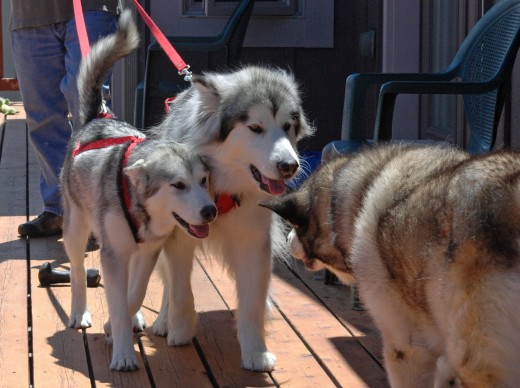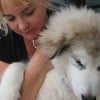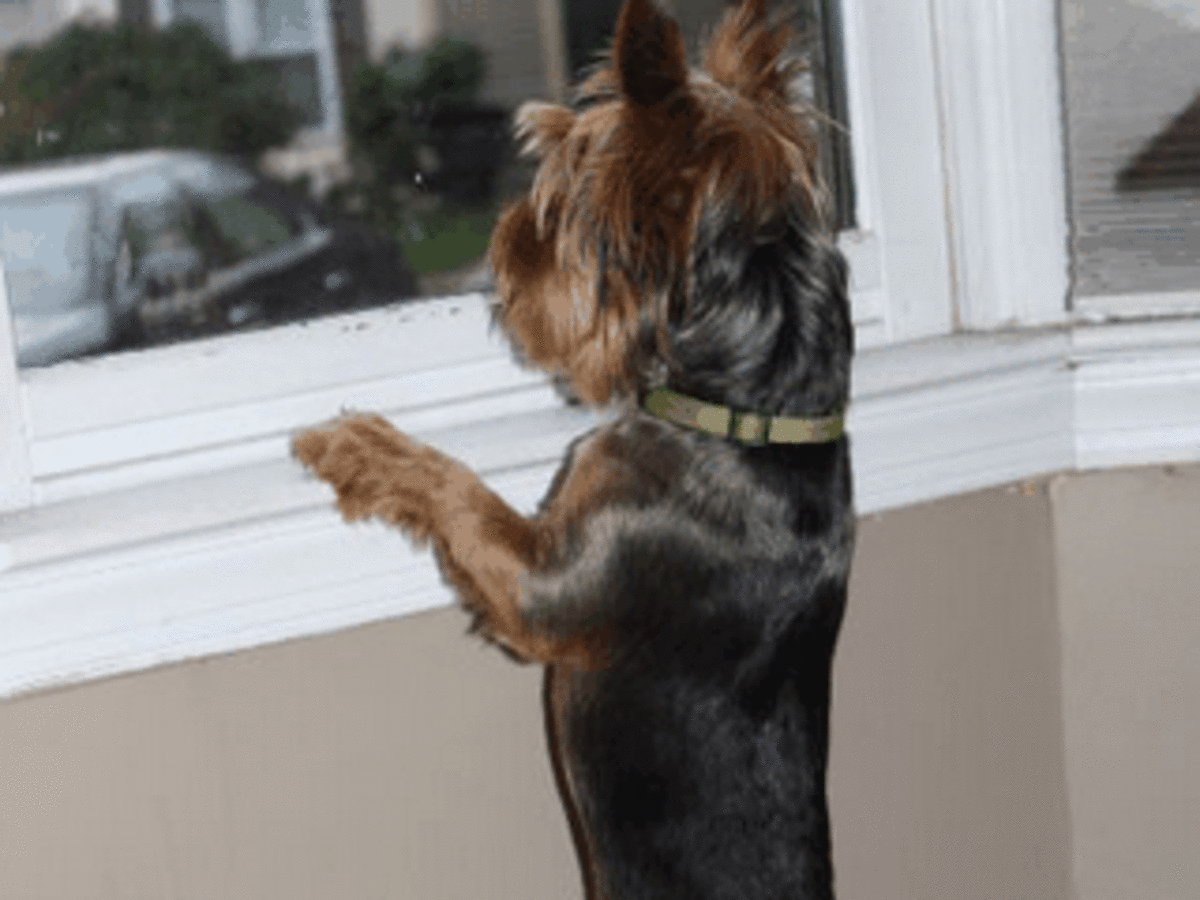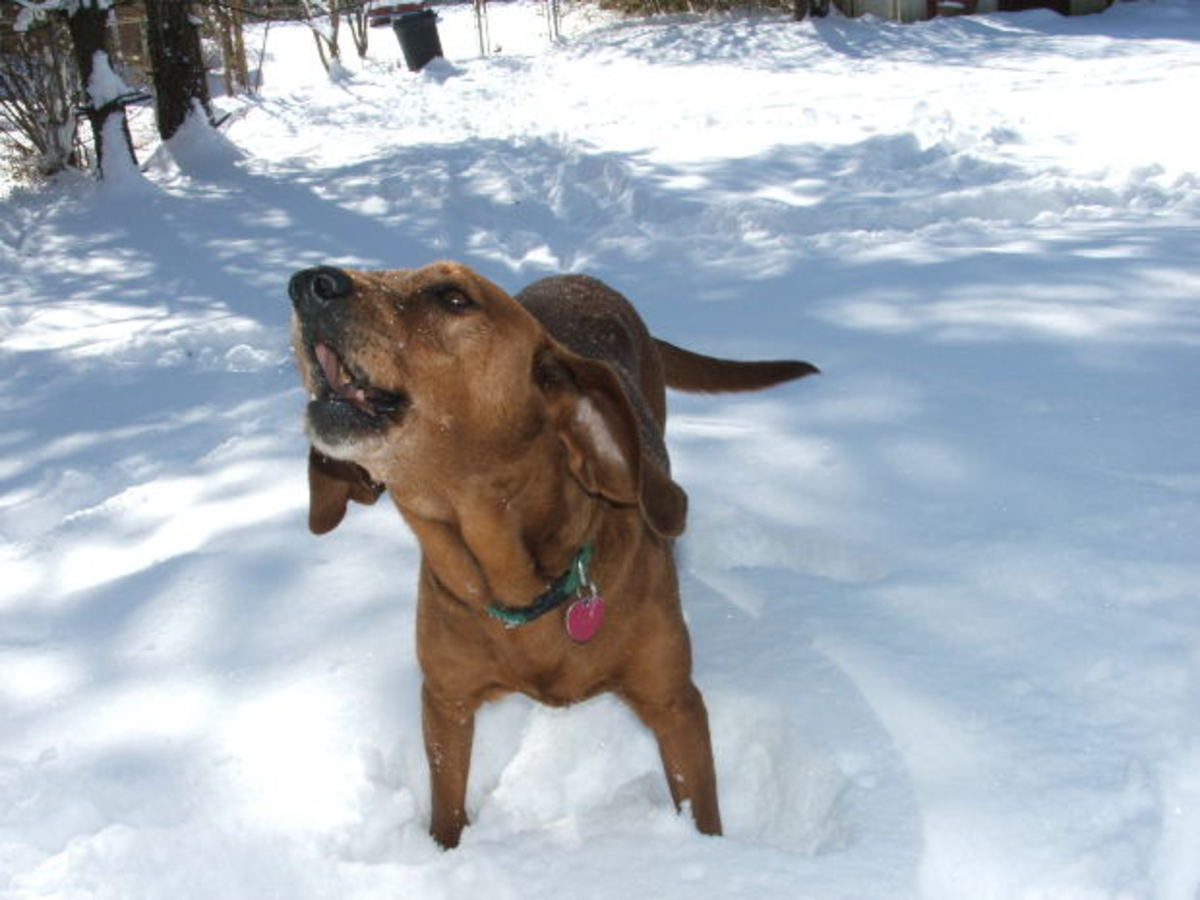How to Communicate With a Dog
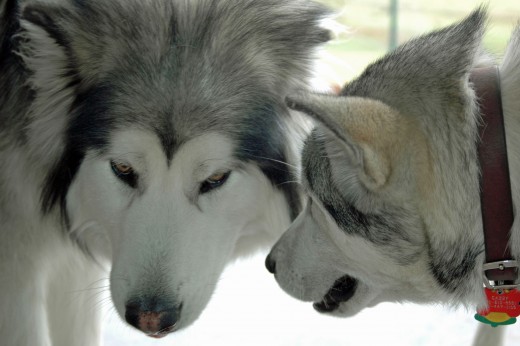
Communication and Dogs
Understanding how dogs communicate amongst themselves can be a very helpful tool in terms of figuring out the best ways to go about communicating with a dog as a human.
Some dog owners feel, even in these enlightened times, that in order to get a point across with man's best friend, you have to be aggressive or overly assertive. I've met dog owners who really shouldn't BE pet owners because they have a Hitler complex when it comes to their dogs.
On the other hand, there are far too many dog owners out there who don't understand the importance of being alpha and that by earning that position, you actually gain the respect of your pet and allow him peace of mind--as in he knows who's the boss and he's content with that.
Speaking dog is in a sense like learning a foreign language or even in some cases, sign language. In the canine world, body language speaks volumes and as the photo illustrates, pecking orders are very much in play. Gabby (on the right) always defers to her uncle Griffin and one can almost imagine her dog voice saying to him "So what do you think we should do Uncle Griff? You decide--you're the boss."
Griffin on the other hand, seems to be contemplating the plan of action--which he will have no trouble conveying to his omega counterpart as soon as he decides what he wants to do. And she will willingly follow him no matter what because they have established their own mode of communication. (In our household, they are both omegas actually to alpha Denaya but Griffin is higher in the pecking order than Gabby who assumes the lower position at this point.)
It works great between dogs. They're able to effectively communicate happiness, malaise, fear, anger, dominance, and a host of other "emotions" or feelings quickly and without hesitation. As pet owners, in order to maintain our alpha status, it's important that we also adopt these skills and know how to effectively communicate, not just coexist, with our dogs.

Figuring Out How Dogs Communicate
This author has 3 malamutes and one of my favorite things to do is just sit back and watch them communicate with each other. Then if you expand that to watching how they deal in the world, it really opens up your mind as to how a human companion can best communicate what you want them to do--and the tricky part--have them understand and respond.
The first step in learning to communicate with dogs is to look at the "emotions" or feelings that dogs have and what they mean.
- Vocalization -- malamutes especially are super vocal and within that one part of their nature, there is a huge variety of reasons why they vocalize. They can show happiness by howling when they want to go for a walk.
They can also vocalize when an aggressive dog is coming at them snarling.
They can also vocalize because they hear another dog howling or bark/howl because they see someone behind the fence.
Malamutes can just vocalize "because"--they want something (like dinner or that friend they want to come and pet them).
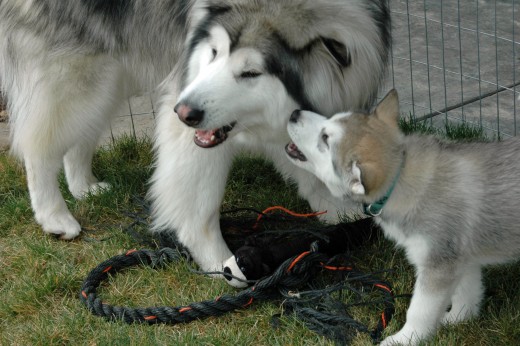
- Eye contact--many people feel that looking a dog in the eye is a dare for dominance. This author disagrees. My dogs making eye contact with me is the only way I will let my dogs eat, come in or do important things. They are required to look me directly in the eye and acknowledge me before they are "released."
Dogs will usually look away after a few seconds but that is a sign of their submission to the human alpha--that is appropriate behavior.
A bad sign is when a dog appears "fixated" on something, isn't responding and its pupils become more dilated. This means that the dog is poised and may be experiencing a fight or flight response.
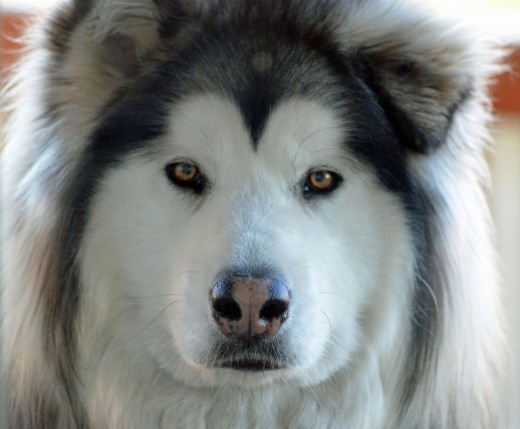
- Posture and body stance -- many dog owners assume that because a dog is wagging its tail that all is well. Consider this--a dog can be wagging its tail merrily along and in the blink of an eye stop wagging which means there's something seriously wrong and the dog can go from relaxed and happy to aggressive and attacking. Why? Because wagging tails don't mean anything--it's all about the dog's body stance and posture.
Wagging can sometimes be a sign of stress so it's best to take in the whole picture. A dog who is focused as if there's no tomorrow is stressed by something and may need reassurance or diversion to keep him or her from doing something bad.
If a dog is standing straight with its tail up and wagging a bit, one can assume that the dog is feeling confident. The pupils are small and the dog is engaged with his or her surroundings rather than rigid or stiff in posture.
A dog who wants to play may bend its body forward with its front legs bowed and its back legs hoisted up in a playful position.
Many breeds (especially mals and other northern breeds) "slam" which means they put their entire body into a sway and playfully bang into each other to show affection, playfulness and even in some ways communicate dominance. They may even "slam" their human counterparts in an effort to play or engage someone's attention.
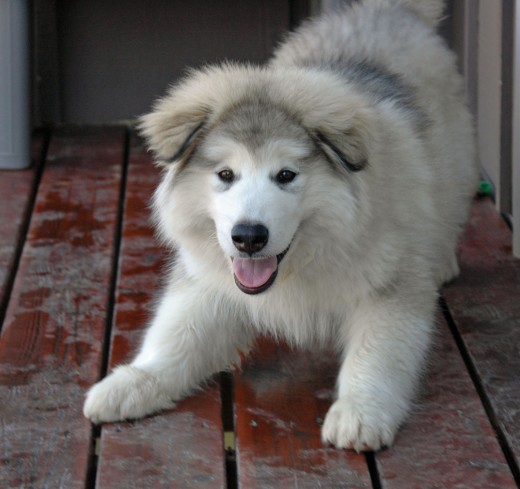
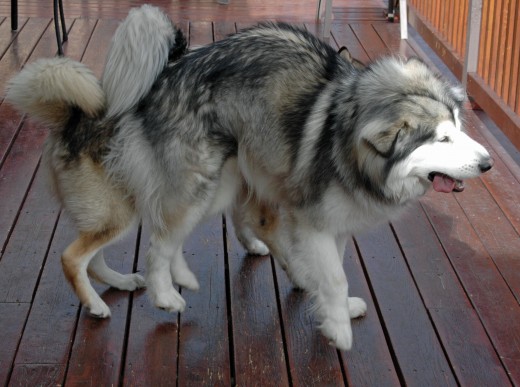
- Rolling over -- this can be a playful behavior as in I want my belly scratched or it can also be used as an avoidance type behavior such as I don't want to go outside or have my nails clipped right now.
- Pacing -- usually dogs pace when they're nervous though some breeds might pace if they're excited, anticipating something like a walk or they may be bored and stressed. My Griffin paces the room the entire time at the vet because it's a very stressful experience (apparently) for him.
- Hackles up -- when a dog raises the hair on its neck or back, that means it has gone to an aggressive or fight mode. It is usually the result of the dog feeling a threat of some kind.
- Cowering, hiding, tail tucked between the legs -- these are all signs of a dog who's experiencing an anxiety reaction or fear. Even though some people feel that a frightened dog isn't a threat, they are simply because they may bite or attack out of fear.
- Aggressive stance or rigidity -- this means a dog has lost itself in the moment and may be on the verge of attack. Their focus is on the object they feel they must fight and this is definitely a situation that can get out of control fast.
- Turning the head side to side -- this can indicate curiosity or mystery. It's a dog's way of being inquisitive and trying to figure something out. Like why is that toy you're holding squeaking at me like that?
- Shaking of the head or body -- a rousing behavior as in getting up from a nap or coming out of a crate. This signals the end of an activity and their intent to move to doing something else.
- Humping or mounting -- this is usually done as a show of dominance--to other dogs and to communicate a desire to be "top dog." Training is a good way to obliterate this behavior because it can be the result of not feeling confident "enough."
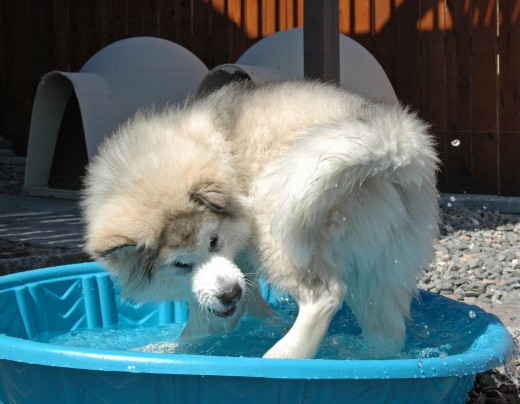
- Pawing or using the head to bump your hand -- this is purely an attention getter. They are saying "pay attention to me right now."
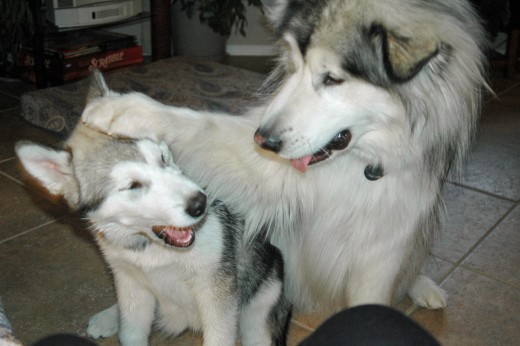
- Tails it is -- different types of tail positions signify different things.
Upright tail (not locked and rigid) means the dog is happy and confident.
A tail which is pretty neutral or lower than the dog's body means he's relaxed.
A tail that's tucked or down usually signifies fear and/or anxiety. Remember that if the tail is tucked or down and it's wagging, that doesn't mean he or she is happy. Wagging can be a sign of nervousness.
Fast wagging can also be a sign of a dog who's decided to do something naughty such as tearing up a pillow or digging a nice big hole!
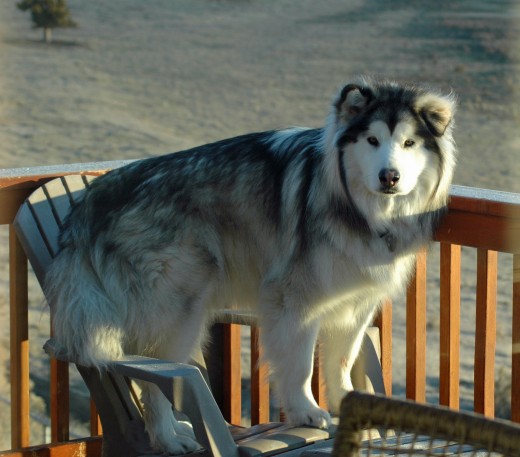
- Ears -- dogs that are paying attention to something have upright ears that may even be more forward facing and illustrates their focus.
Flattened ears mean the dog is fearful.
If the ears are in front and close to the head, it can indicate aggression about to happen.
On some dog breeds, the ears pulled back but not flat can be interpreted as sadness or feeling badly.
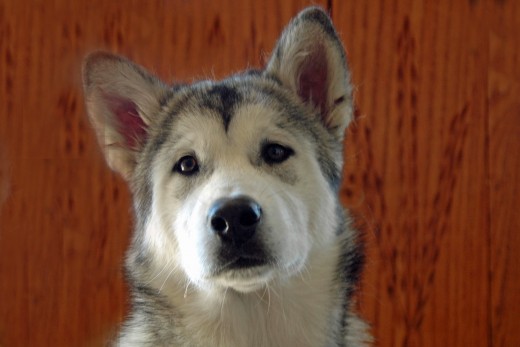
- Eyes -- fully open eyes means the dog is engaged and ready for anything.
A dog who goes into a staring contest may be thinking of exerting dominance or becoming aggressive to establish his place in the "pack."
Dogs who avoid eye contact with humans or other dogs are submissive by nature and mean to show they are omega rather than alpha.
Winking or blinking may be a sign of fun and games.
A dog with fierce, narrowed eyes usually indicates aggression or attack mode may be near.
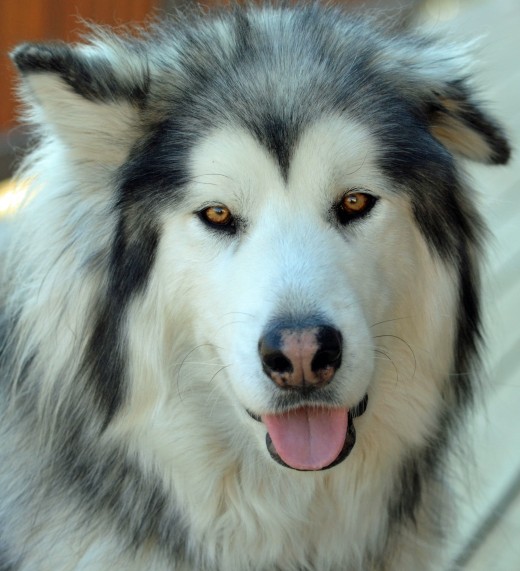
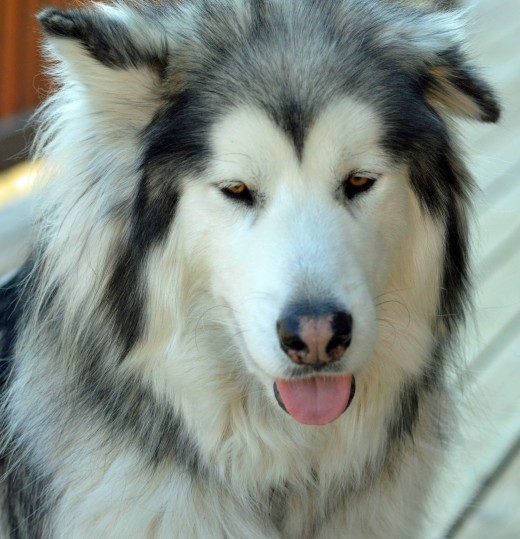
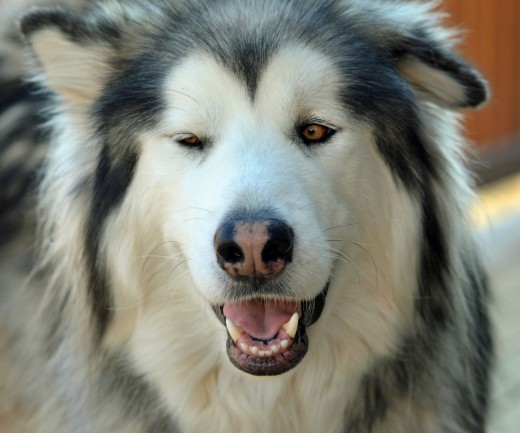
- Yawns -- a yawn can mean a dog is tired just like humans. It can also be a release of tension.
A dog may also yawn in new situations.
Dogs and people both have yawns which are contagious.
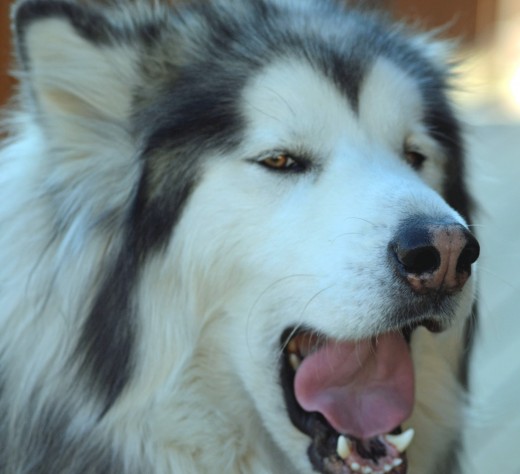
- Smiling -- if a dog is relaxed and happy, he or she can smile!
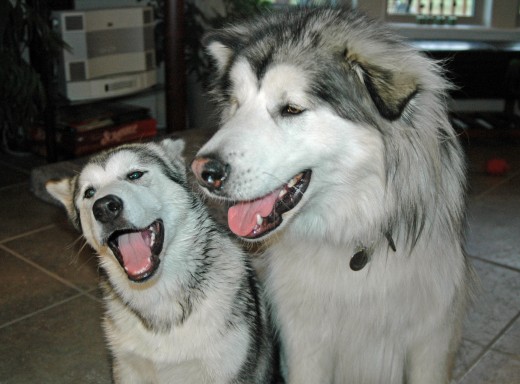
- Licking lips -- if a dog is excessively licking its lips, it can indicate stress.
However, when a dog licks another dog (as my younger mal does to our older mal often), it shows that she is submissive to her.
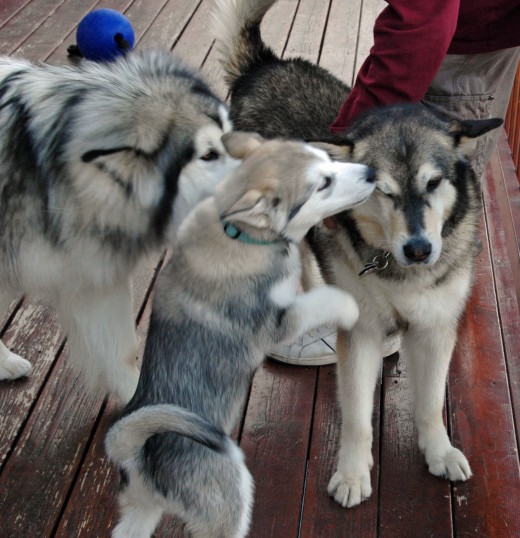
- Snarling or teeth showing -- this indicates aggression and the intent to bite. It's usually associated with a rigid posture and/or hackles up.
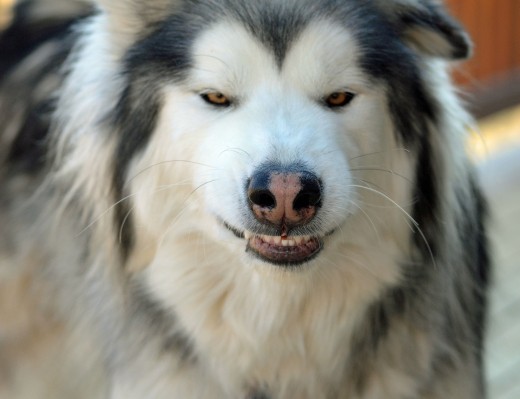
Human to Dog Communication
So how does the human counterpart speak dog in such a way as to coexist with their faithful companion and still maintain a mutually satisfying relationship? Very carefully! Actually it's not as hard as it might seem.
What a dog owner should avoid is one of two scenarios that really are not good for the dog and certainly don't lend themselves to happy pet owners (or the people around them).
- You don't want a dog who is afraid of your every move, look or word--while some people believe this is the right way to exist with a dog, I vehemently disagree as it is only a means to dominate an animal.
- Just as ineffective is the relationship where the dog is leader of the pack and the owner isn't capable or unwilling to take back the alpha role. Surprisingly, this can be seen in situations with small dogs (in fact quite often) just as easily as with larger or more "difficult" breeds, such as this author's infamous malamutes. Small dogs can take over much more easily sometimes because people don't feel threatened by their size.
The ideal communication between dog and his owner or family is one in which they understand each other but most importantly, they respect one another.
In the dog world, respect must be earned. Dogs are one of the smartest creatures on the planet and they do have standards. In order to be leader of the pack, the human counterpart has to prove that they will take care of the dog or dogs, provide for them, and protect them should the need arise. In the natural world, that's what alpha means.
So how do you communicate with a dog and get "down to his level" in terms of getting what you want out of the relationship?
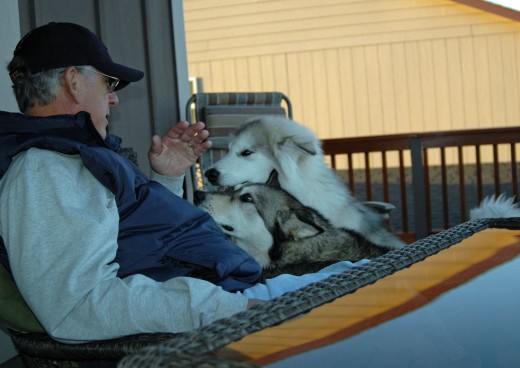
Communicating with Your Dog
- Speak to your dog in a tone of voice they understand
High pitched, squeaky and happy voice means excitement. If you don't want your dog to react and react in an exuberant way right now--don't use it! Think of this when you approach other people's dogs as well. Many people squeal exuberantly while approaching my 3 malamutes on leash exclaiming "snow dogs" in high squeaking voices....coming straight at them. Why? Because they're excited. Yet the humans seem to be astounded that my dogs respond by being...well....excited and literally freaking out! They gave them the wrong message! Use this voice when you mean to be crazy, when you want the dog to run and howl and play full out with you. Don't use it for commands or for "casual" interaction.
Normal tone of voice. Use this much as you would with a family member or a friend. "Let's go outside, Griff" or "Let's go" (moving them on from a halt/sit at a corner on a walk). Dogs consider your normal voice your relaxed mode and they will be relaxed as well.
Stern and lower register voice. Even if you're a woman, stern is good in terms of dog speak. Even combine it with body actions such as stomping your foot. Malamutes can be quarrelsome and get into snits with each other from time to time. I've never had to physically break up a dog fight but I've been in on the beginning of one. All I've had to do is use my stern voice (LOUDLY) and stomp my foot. When your dog is doing something you don't like, he or she needs to know you mean to point that out. You can't do a soft, high squeaky voice to get this point across. You have to use a stern, chopped, louder, deeper voice to let them know it was not something you wanted them to do. Just like kids, discipline and authority are necessary.
Clicks, whistles, kissing noises. All of these can be signals and used as you develop them with your dog. I use a series of verbal clicks if I want my dog to pick up the pace while running (much like in horseback riding). This transfers later on to scooter work. Anything you use to communicate with your dog that works, keep it in your tool kit. - Body language. Dogs are physical by nature whether they're small or huge. They slam each other, they hump each other to show who's boss and they growl and snarl at each other to establish pecking order or teach younger pups a lesson. No--we don't have to hump our dogs or bite them to get their attention. But we do have to keep in mind how their brain and personalities work.
Let's get physical. Most dogs respond better to thumps, pats, even tussles to communicate. Cuddling is great but most dogs want some actual demonstration of physicality from their owners. This author wrestles with all our malamutes on a regular basis though I've learned not to encourage certain behaviors such as nipping, pinning, or overly aggressive behaviors. Dogs can become confused by these types of "play" behaviors, especially certain breeds. This is not to say that our play times are not rambunctious but they are "in control"--by the human. The last thing I want to train my dogs to do is to become overly excited and misinterpret play for the need to attack or be dominant towards anyone.
Don't tower over your dog. While being alpha is really important, dogs that are threatened usually don't respond as well as dogs that are confident. Get down to their level and you will have much more success in getting them to trust you, getting them to respond to you, and getting them to want to please you.
Don't approach dogs straight on -- especially at a fast pace. I can't stress this enough. I have 3 really big dogs. When people excitedly come marching at them squeaking and squealing I seriously wish I had a tazer. REALLY? I want to say "stop right there and think this through" but it usually happens so quickly it's out of my control. Approach a dog from the side and you are not a threat. Extend your hand and show them that you are not a threat and things will go much better--for the dog and for the owner who might happen to be standing there holding 250+ pounds of quivering, happy dogs. - Remember the positive reward system. If you really want to have a good dog and one that communicates well with you, sweeten the pot by remembering the old addage about you attract more flies with honey than vinegar. If your dog gets the idea that he or she is doing something really cool that totally pleases you (by way of it being reinforced with treats especially but praise as well), you've established a great way of communicating. You've let your dog know you plan on rewarding him or her for things you want repeated. That's priceless. It's like giving them an allowance!
- Forget the past. If your dog does something and you don't catch him or her in the physical act of doing it--leave it alone and do not by any way or means try and correct them for it. It's a training moment gone and unfortunately you need to wait for the next one. People who believe that their dog "knows" they did something bad may be right but trying to discuss it with them after the fact or worse, punishing them after the fact--waste of time and unfair to the dog. Concentrate on what you can correct while you are physically present. It's called training for a reason and goes on for a long, long time no matter what age the dog.
- If you can't make time for your dog, you should not have one. Same as with kids. A dog needs your attention, not just food and water and shelter. A dog needs you, the human, to love them, to communicate with them, to exercise them and also to stimulate them. Most dogs need a job or an activity or exercise. Without that, they do bad things. So if you decide to take on the responsibility of a human canine relationship--you need to be aware that it will take up your time. Just like any other real relationship.
- Don't abuse your dog for any reason! I don't care how bad a dog is or how many things a dog gets into, does wrong--there is absolutely NO excuse for hitting, punching, kicking, throwing, or otherwise hurting a dog. Especially one you have to be your faithful companion. Abuse is abuse and rather than teach the dog a lesson or extort obedience, you will make the dog loathe you and be afraid of you. Most importantly, a dog cannot respect someone who is abusive--the way of the wild is to EARN respect not demand it, especially by physical abuse or neglect. "Dogs are people too" is a popular way of thinking of our canine partners. This author has little tolerance for people who seek to exert their "strength" over animals who only want love and care. Please don't be "that guy."
- Have a set of rules. People who let their dogs determine who goes out the door first, who gets the most part of the bed, who can grab food off the counter, etc. are letting their pets call the shots. Just like in any relationship, you have to have rules and they should be consistent. Train your dog to do the right thing and they will! They want to please us and they want a positive relationship, not a negative one with us. Since humans are the ones with the bigger brain and the reasoning ability, it stands to reason that WE should be the ones who write the rules, not our dogs. Sometimes, it takes actively sitting down and writing a list of what we expect from our dogs--and then setting about getting those behaviors to happen. Like counter surfing. This author has been working on this very typical though aggravating malamute behavior for some time and it does work--but you have to be consistent and expect success.
Communication with Dogs
Talking to Your Dog
Many people say to this author "they're just dogs." I do agree that indeed they are just dogs but then on the other hand, the dogs I've been privileged to know over the years have always snuck into my heart and taught me something--about life and about myself.
While they aren't human, I'd almost rather have some of my dogs in my life over some of the people I've encountered. As a general rule, I've always found dogs to be respectful and easy to deal with but I think my attitude towards them has helped make that possible.
In this author's humble opinion, the days and years we have with our dogs are far too short and one of the most precious gifts we can receive. It's vital to make the most of our time with them and learn to communicate to ensure a happy and memorable experience. I've been fortunate so far to have had many wonderful companions and a scrapbook full of unforgettable moments.
